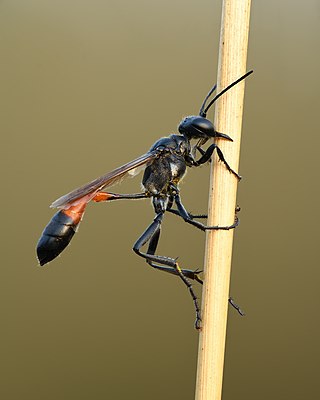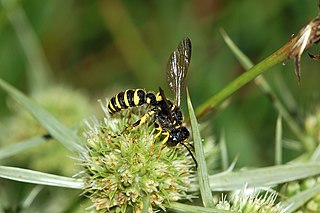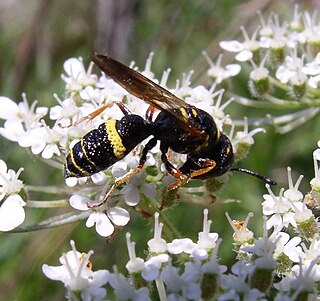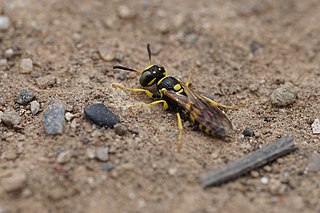
The Sphecidae are a cosmopolitan family of wasps of the suborder Apocrita that includes sand wasps, mud daubers, and other thread-waisted wasps.

The Tasmanian pygmy possum, also known as the little pygmy possum or tiny pygmy possum, is the world's smallest possum. It was first described by Oldfield Thomas in 1888, after he identified that a museum specimen labelled as an eastern pygmy possum in fact represented a species then unknown to science. The holotype resides in the Natural History Museum in London.

Beewolves, also known as bee-hunters or bee-killer wasps, are solitary, predatory wasps, most of which prey on bees, hence their common name. The adult females dig tunnels in the ground for nesting, while the territorial males mark twigs and other objects with pheromones to claim the territory from competing males.

The European beewolf, also known as the bee-killer wasp or the bee-eating philanthus, is a solitary wasp that lives in the Western Palearctic and Afrotropics. Although the adults of the species are herbivores, the species derives its name from the behaviour of the inseminated females, who hunt Western honey bees. The female places several of its paralysed prey together with an egg in a small underground chamber, to serve as food for the wasp larvae. All members of the genus Philanthus hunt various species of bees, but P. triangulum is apparently the only one that specialises in Western honey bees.

Philanthidae is one of the largest families of wasp in the superfamily Apoidea, with 1167 species in 8 genera, most of which are Cerceris.

Philanthus gibbosus, the hump-backed beewolf, is a species of bee-hunting wasp and is the most common and widespread member of the genus in North America. P. gibbosus is of the order Hymenoptera and the genus Philanthus. It is native to the Midwestern United States and the western Appalachians. P. gibbosus are often observed to visit flowers and other plants in search of insect prey to feed their young. The prey that P. gibbosus catches is then coated in a layer of pollen and fed to the young wasps.

Philanthus pulchellus is a species of bee-hunting wasp of the Iberian Peninsula. Males are territorial and establish territories in nesting areas of females, or in the case of smaller males that are unable to do so, nearby. Females are generalist predators of bees and wasps, including conspecifics, and store the prey in their underground nest.

Philanthus multimaculatus is a species of bee-hunting wasp, or beewolf, found from British Columbia and Alberta south to Zacatecas and San Luis Potosi.
Philanthus pacificus is a species of wasp in the family Philanthidae. It is found from southwestern British Columbia to Baja California and Sonora.
Philanthus sanbornii is a species of wasp in the family Philanthidae. It is found in North America.

Sphaerophoria philanthus is a species of syrphid fly in the family Syrphidae. It is found in Europe.

Podium luctuosum is a species of thread-waisted wasp in the family Sphecidae. It is known to provide Parcoblatta as prey for its larvae.
Glenostictia pictifrons is a species of sand wasp in the family Bembicidae. It is found in North America. It is known to be a predator of many types of flies, including the bombyliids that are parasitoids of Glenostictia, and rare fly species such as Neorhynchocephalus volaticus.
Philanthus solivagus is a species of wasp in the family Philanthidae. It is found in North America.
Liris argentatus is a species of square-headed wasp in the family Crabronidae. It is found in the Caribbean, Central America, North America, and Oceania. Females overwinter as adults.
Prionyx fervens is a species of thread-waisted wasp in the family Sphecidae.
Ammophila aphrodite is a species of thread-waisted wasp in the family Sphecidae. It is native to the southwest United States.

Philanthus bilunatus is a species of wasp in the family Philanthidae. It is found in North America.
Sphex tepanecus is a species of thread-waisted wasp in the family Sphecidae.









